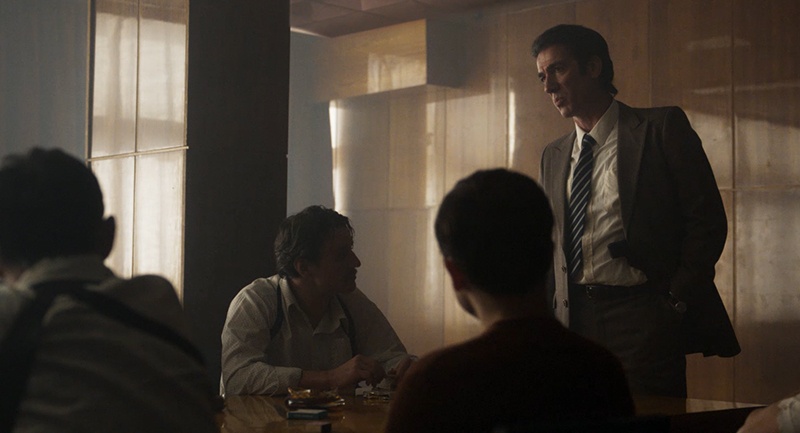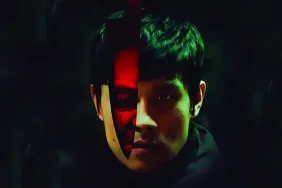Lado Kvataniya’s feature film directorial debut is a tension-filled neo-noir psychological thriller that largely takes place during the decline and collapse of the Soviet Union, centering around a case involving a brutal serial killer dubbed The Butcher that spans between 1978 and 1991. Co-written by Olga Gorodetskaya, the story kicks off with a wounded survivor, presumably a victim of said serial killer, bursting out of a Russian forest in 1991 and escaping the perpetrator with her harrowing tale and wounds sparking suspicions that the case that was previously thought solved by newly-promoted police chief Issa Valentinovich (Niko Tavadze) might not be closed after all.
The alternating timelines in the film help navigate the various mysteries from the past and present — as well as introduce our key characters — and are immediately presented in the gripping opening scene as one victim from 1988, stabbed in the back, attempts to flee but doesn’t succeed in escaping the way our survivor, Kira, does. Time moves seamlessly back and forth over the years throughout the film, with dates clearly labeled, never leaving you confused as to which decade of the tale you’re in as the events unfold. The nonlinear timeline was a smart choice on the filmmakers’ part, particularly due to the sheer number of mysteries that pile up before many truths are harshly peeled back as the clock ticks away.
As the culture around them shifts, so do the significant relationships in the story; but like everything else, these changes occur in a nonlinear fashion that allows us to start asking questions about the characters outside of the extremely violent serial killer at the center of this investigation. We begin to wonder why Issa and his former investigative partner Ivan Sevastyanov (Evgeniy Tkachuk) have seemingly had a falling out years after they teamed up on the original case, what caused Issa’s marriage to his wife, Nadia, to slowly and profoundly fracture (and why does she remain so loyal?), and what role does a woman named Vera have in all of this, among a list of inquiries that are satisfyingly addressed before the credits roll. Additionally, the see-sawing movement through time not only drives us to the conclusion before the final chapters that there may be more than a singular perpetrator at play here, but it becomes the most important tool in revealing the movie’s biggest revelations — some shocking, others a bit too obvious.
Beyond the movie guiding the audience through the several time jumps, along with separating the story in chapters meant to reflect the stages of grief – such as denial or anger – the movie’s visual storytelling is as clever and carefully crafted as its many mysteries, especially regarding the use of color. In the present, aka 1991, any bright shades or vivid colors that existed in the film closer to 1978 begin to gradually disappear until we are left with a monochrome look, reflecting the state of our characters after everything went to hell as the years went on.
Even with all of these tools expertly utilized by Kvataniya, the film hinges on the powerful, raw performances of the main cast members — from the “heroes” to the killers and those unlucky enough to know or cross paths with them — and they all deliver, especially during the movie’s most crucial scenes. I say hero loosely because, with perhaps one or two exceptions, the story arguably lacks the type of heroism you may be expecting stepping into a film like this. The investigators themselves are depicted as being just as capable of inhumane or deranged acts as the murderers they come face-to-face with; it’s hard to feel empathy for any of the key characters outside of the victims and the women lucky enough to survive the sadistic brutality, bloodlust, or violent, vengeance-fueled plots by the men around them, badge or otherwise. The police are as quick to turn to torture and extreme interrogation tactics as our killer is to slice up someone and stuff mud into their mouths.
Our main character, Issa, is crumbling under the pressure of his higher-ups demanding a solution to the case along with the public’s scrutiny (especially amidst the disintegration of the USSR) and his own nefarious secrets threatening to claw to the surface. No matter the point in time, though, violence, lies, rage, and vanity remain at his core; his own wife is not spared from his viciousness. Then you have Ivan, who has the opportunity to be our real hero, but tragically has a darkness that cannot be ignored especially when he acts on certain impulses in the face of his own desperate need for vengeance, a desire that causes harm and overcomes proper paths to justice (if there are any possible by the end).
The corruption, toxic masculinity, cruelty, and immorality among the investigators as well as the killers sit at the center of the story, where comparisons are intentional in that we are dealing with the examination of people at their very worst and the reality of their existence. While the detectives may not be on the exact same playing field as a suspect accused of killing 36 women and committing “acts of sexual and sadistic abuse of their corpses,” they are beyond redemption by the time the curtain call comes – which at least one of them seems to understand unequivocally and makes the conclusion of the story all the more satisfying while tying the entire nonlinear narrative together.
The exploration of that tragic darkness, along with the corruption and toxic masculinity is the point; the movie was never a story about heroes or even good versus evil, but a psychological study into these intertwining characters submerged in a giant ball of complex mysteries unraveling on-screen that prove difficult to turn away from, even at their bloodiest. The Execution presents a jigsaw puzzle for the audience to solve as we seek out the story’s antagonists and fail to find the “good guys,” and succeeds in leaving viewers satisfied, disturbed, and with the reminder that not every story comes with a traditional happy ending — and oftentimes, particularly in a movie like this, that’s the right call.
SCORE: 8/10
As ComingSoon’s review policy explains, a score of 8 equates to “Great.” While there are a few minor issues, this score means that the film succeeds at its goal and leaves a memorable impact.
Disclosure: The critic was sent a screener for the film during Fantastic Fest for our The Execution review.










